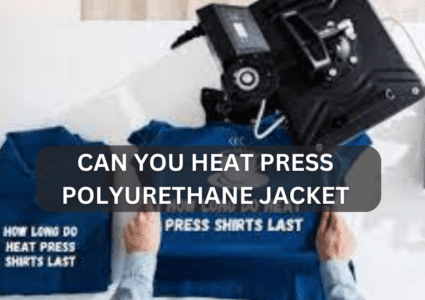Heat press and its questions are the talk of the town these days and people on the internet are searching about it to start with their own ventures. On the other hand, given the emergence of polyurethane clothing, decorators have had to discover the finest techniques for printing unique graphics onto polyurethane fabric.
There are undoubtedly difficulties when heat printing on polyurethane. Unlike to popular cotton t-shirts, the fabric seems more challenging to embellish. Nonetheless, don’t be put off by polyurethane. Because at the end, it’s all easy and convenient when you got the right information.
Considering that. Today I will be taking you through a detail information about polyurethane jackets. But before I will answer that can you heat press polyurethane jackets or not. To find out, let’s read our experts team intake on the topic and much more! Better begin now:
Can you Heat Press Polyurethane Jacket?
PU jackets are always a trend that never goes out of the style but since it is a long lasting, Gen Z are all into making it look different and more cool than ever before. Also, it is undoubtedly less expensive than genuine leather, and at first glance, you cannot tell the difference. Ultimately, though, after wearing the item for a while, you can tell the difference.
But talking about the heat press, people are still confused whether to use heat press on polyurethane jackets or not. Well, Yes, you can use the heat press but the use comes with its own set of pros and cons as well as some precautionary measures too. So, you must be ready for that!
Factors to Consider for Heat Press on Polyurethane Jackets
For heat pressing the polyurethane jackets, it is a must to consider few factors as you can ruin your PU jacket when doing the heat press with the normal settings. So, let’s see here the detailed factors that one should know for the better!
Design:
Always try to keep the designing space as separate as possible for the design. Also, in order to maintain the clothes practical, you should only remove the covering where it will be personalised. As I mentioned, you may separate an area by either elevating it with a Heat Press Cushion or by marking it with a pencil.
Temperature:
When it comes to the temperature, a low heat setting is required. It will safeguard your garment from burning or any other heat-related risks. The heat transfer will therefore be sufficient around 270–280 ° Fahrenheit, in my opinion.
Polyurethane is a type of synthetic leather. Hence, the entire jacket is plastic-covered. To avoid ruining the entire clothing, you must adjust the temperature at a very low level so that it heat transfers your pattern.
Time span:
You must apply a little bit more pressure and hold it for a little bit longer to cover the low heat, it is roughly 1.5 to 2 minutes. Also, you must only use heat when printing. In order to dry the fabric, pre-heating is used. Avoid overheating by not burning your jacket. That being said, to successfully transfer your design, don’t press it down for an excessive amount of time.
Condition:
Products made of polyurethane must be dried as it will facilitate the bonding of your vinyl glue to the clothing. Also, you need to make sure that you separate the part you want to print because the color can be affected.
3 Do’s of Heat Pressing Polyurethane Jackets
The dos and don’ts are equally important as the above-mentioned question. So, let’s discover these now!
1. Testing the fabric:
The most important thing to do is to check the fabric, for that you must do the patch testing. First, do a patch test of a small piece and see what temperature, time and the settings suits the best to it.
2. Choose the transfer:
Each type of transfer has a verified fabric type it adheres to, as well as the time, ph., and pressure requirements for correctly applying the transfer to the cloth. Since we are here all talking about the eat press, so yes that’s the best transfer you can go with.
3. Check for dye dispersion:
Dye diffusion happens when a cloth dye that was previously inactive during heat printing is now reactivated, enabling the dye to bleed or move into the beautifying substance, such as ink or vinyl.
Don’ts of Heat Pressing Polyurethane Jackets
1. Use of thick sheets:
With heat printing, cover sheets are intended to be placed on top of your heat transfer. But this might be the best way to avoid burn marks. Also, they are blocking your transfer from receiving the necessary amount of heat to apply.
2. Setting the high temperature:
When heat printing on customised clothing, temperature is a key factor. To attach the transfers glue or ink to the fabric, you use a “heat” press. However, there is a fabric issue with this and polyurethane is the difficult fabric to deal with. So, you better set the temperature at low to moderate settings.
Final words:
There are so many options out there in the market but if you particularly ask me to choose one, it will be the heat pressing method that suits the best to polyurethane jackets. But, here are some particular settings and factors that you must know.
So, above in this article I have discussed almost everything from the question to its detail guide for you. You can always come back to re-read the article and if you got any question, you can ask that too!

I’m Henry Collins and living my happy life. I’m a professional businessman and I own and run 6 Heat Pressing Services stores where I provide my clients with custom Designs on hats, mugs, T-Shirts and a lot more using Heat Press Machine. Been using a heat press for the last 4 years and people love my work. As I’ve got enough information on Heat Press I decided to make a blog on it and share my knowledge with the world. I hope, the world will appreciate it.

